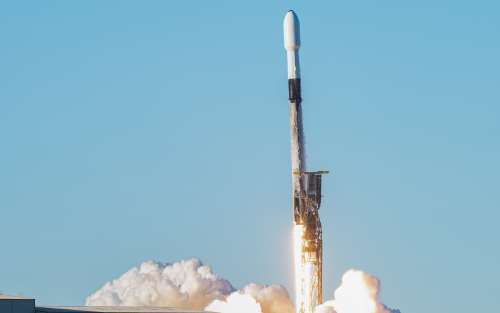The United States Space Force (USSF) successfully delivered the USSF-62 mission carrying a next-generation environmental monitoring satellite system, known as Weather System Follow-on Microwave (WSF-M), into low Earth orbit. The satellite was launched aboard a SpaceX Falcon 9 rocket from Space Launch Complex-4 out of Vandenberg Space Force Base East on Apr. 11 at 7:25 a.m. PDT.
“This was a tremendous launch campaign with many firsts, including but not limited to, reuse of a previously flown booster whose history was purely commercial, and for the first time, flying a previously flown payload fairing on an NSSL mission,” said Akhil Gujral, General Manager of the Launch Systems Division at Aerospace.

The mission was the fourth USSF launch so far in FY2024. As with prior National Security Space Launch (NSSL) missions, The Aerospace Corporation provided integrated support across a breadth of activities, including independent and objective assessments, in support of the USSF’s Space Systems Command (SSC) and its mission partners.
The team operated with speed and agility, demonstrating our cultural attributes without compromising mission success,” said Randy Kendall, Vice President of Launch, Missiles and Mobility at Aerospace.
The ability to re-use boosters enables savings on costs, storage and handling, and allows for added flexibility to manage launch manifests, according to SSC.
"Along with the commercial sector, we realize the benefits of reusability with every launch,” said Dr. Walt Lauderdale, Falcon Division Chief and Deputy Mission Director at SSC. “We’ve achieved excellent savings of tax-payer dollars and have expanded reuse to leverage the benefits for all our mission partners.”
USSF-62 delivers the first of two WSF-M satellites that bring new capabilities to the nation and its allies. According to SSC, the WSF-M satellites will provide increased ability to measure microwave frequencies to determine sea surface winds, tropical cyclone intensity and additional environmental data that will further augment joint warfighter capabilities.

“The successful launch of SSC’s WSF-M satellite is a tremendous accomplishment for the entire team and marks a pivotal moment in the U.S. Space Force’s space-based environmental monitoring mission,” said Col. Robert Davis, Program Executive Officer for SSC’s Space Sensing. “We are looking ahead and are strategically positioned to ensure our warfighters have the vital environmental monitoring data necessary for effective mission planning and operations globally."
In addition to supporting the launch mission, Aerospace provided its technical expertise in support of SSC and its partners across the WSF-M mission lifecycle, which provided independent and objective assessments to support critical decisions during mission campaign.
“We had a fantastic launch today. Working together with our mission partners, we placed an important asset on-orbit that adds remarkable capabilities for the nation and our allies,” said Col. Jim Horne, Senior Materiel Leader for SSC’s Launch Execution Delta and the Mission Director for USSF-62. “National security space launches like USSF-62 are a testament to our resolve to increase our warfighting advantage."
According to USSF, the WSF-M satellite will soon replace and improve upon key capabilities currently provided by the legacy Defense Meteorological Satellite Program. The data gathered by WSF-M will support of a wide variety of weather products necessary to conduct U.S. and allied mission planning and operations globally.
“The on-orbit delivery of the WSF-M satellite represents a significant milestone that reinvigorates the DoD’s presence and commitment to provide Space Based Environmental Monitoring,” said Dr. Michael Bolla, Principal Director of Environmental and Tactical Surveillance at Aerospace. “The Aerospace team provided critical technical and programmatic guidance and an agile mission assurance approach to the successful WSF-M acquisition beginning in 2017. Going forward, we will support the on-orbit testing, calibration and validation, and delivery of the operational weather data products to the warfighter."

